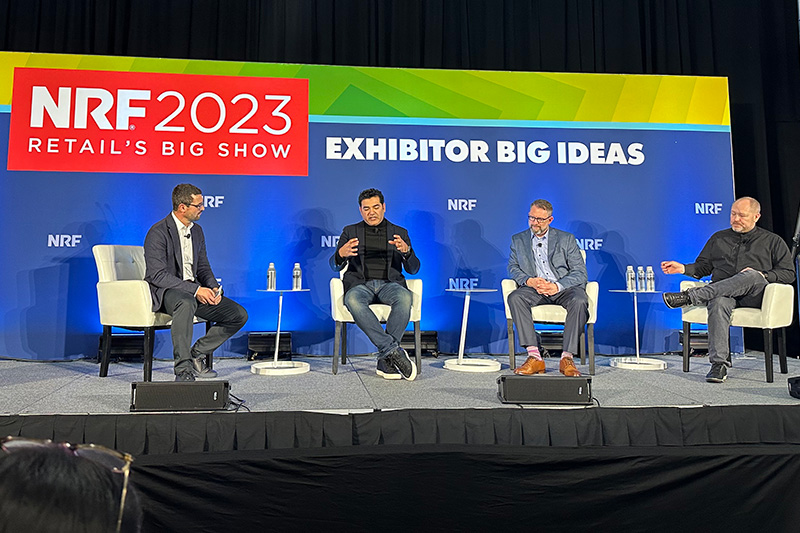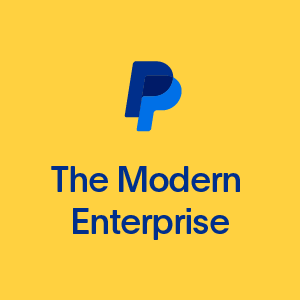
NRF Retail's Big Show panel, January 2023
In any company, understanding a customer's needs and wants is the cornerstone of the business, but in payments, having a deep knowledge of a consumer’s shopping behavior and purchasing patterns can pay off in spades.
That was one of several key takeaways from one of the panels featured at the National Retail Federation’s annual conference this past January in New York City. Payment executives and analysts sat in front of a packed room discussing steps they have taken to remain ahead of the competition.
The panel, titled “Translating consumer behavior into action for your business,” featured Hani Batla, Chief Information Officer and Chief Technology Officer at Adorama; Daniel Crisologo, Director of Payments at Nordstrom and Brendan Witcher, Vice President and Principal Analyst at Forrester Research. The panel was sponsored by PayPal and moderated by Frank Keller, the company’s GM and senior vice president of merchant and payment platforms.
Here are four pieces of advice the panelists shared with retailers in the audience.
Know your customer and incorporate in-line commerce

Hani Batla, CIO, CTO, Adorama
Knowing your customers and the channels they like to engage in affords retailers more opportunities to re-engage them at different touchpoints with new, relevant, and valuable offers, said Hani, Adorama's CIO and CTO.
He said in-line commerce – the ability to seamlessly serve a related product to the consumer – can be a powerful extension of a transaction.
“As we try and build out an entire experience, the very last point in that journey [the point of payment] is where we end up losing the most people, and that’s the one area of opportunity where personalization matters most,” he said.
To combat this, the company – which specializes in professional audio and video equipment -- has been laser-focused on its checkout experience. They’ve integrated in-line commerce, offering, for example, customers who buy a camera lens meant for landscape photography other items such as outerwear, boots, or camping gear.
“[A purchase] is the opportunity for a data point on that person,” he said. “If you’re buying that camera lens, we know you’re not going to sit in your apartment and take pictures of your dog.”
Maximize commerce opportunities

Daniel Crisologo, Dir. of Payments, Nordstrom
At fashion retailer Nordstrom, the focus has also been gaining a holistic view of their customers and offering consistent payment options, whether they are buying in-store, online or at the Nordstrom Rack.
“Payments is no longer an expense channel. At Nordstrom, it’s a strategic business unit,” said Daniel, Nordstrom's Director of Payments.
“We spent a lot of time making sure that the payment options we have today are the same everywhere,” he said. “We learn from the data we’re collecting and as we are evolving, we try and be a little more proactive and less reactive.”
He said that includes introducing new financing options and the ability to store purchasing cards on file.
“We are focused on the digital experience and card-free shopping, making sure you’re not strapped to your wallet or card. How do you do that efficiently and in a secure way? It all comes down to data.”

Brendan Witcher, VP and Principal Analyst, Forrester Research
This type of invisible “set-it-and-forget-it” commerce is already common, with consumers comfortable paying monthly for streaming services or storing their card in a marketplace for easy one-click purchases.
Brendan, from Forrester Research, said it’s all about simplifying the process while providing as much flexibility as possible for consumers.
“We are getting used to having payments happen in the background without us even thinking about it,” he said. “We’re moving towards the idea of making life simpler by taking out something that just isn’t going to add a lot of value but leaving it in if a consumer wants to make that choice.”
Find the right partner
Daniel said that by working with employees to understand pain points as well as partners like
PayPal that have solutions that help acquire new customers and retain current ones, Nordstrom is aiming to create a modernized payments strategy that is well-equipped for the future.
He advised other retailers who operate without teams focused on payment strategies to find a partner who will help them fill some important gaps.
“Focus on the ones that have a very large population as far as customer growth, retention, and acquisition, and leverage their marketing experience and their data. If you don’t have the infrastructure in place to help with orchestration and things like that, I would start talking to those folks,” he said.
Orchestration, which means having a single ecosystem of complementary business solutions that seamlessly integrate with each other, not only drives efficiency but conversions, Hani said.
“This is what we enjoy in a partner like PayPal and PayPal
Braintree. Now, in the background, when you’re on the right platform and have the right partners, even the payments behind-the-scenes gets split up the right way and things are just simpler so it’s easier to keep building on these blocks and start doing more of that in-line commerce.”
Hani said Adorama saw a massive uptick in conversion and a drop in shopping cart abandonment by simplifying their checkout experience.
For example, the retailer recently integrated
Venmo as a payment option and used PayPal Braintree to facilitate all of Adorama’s Alternative Payment Methods (APMs) in a single integration. (Examples of APMs include e-wallets, Buy Now Pay Later Products and other non-traditional payment options.) Not only was it a low-lift for the merchant, but Adorama saw their efforts pay off. Venmo’s Average Order Value (AOV) is $403, which is the highest of all APMs. Furthermore, 42% of their Venmo customers were net new.
Keep it simple
Just like orchestration is meant to simplify the backend for merchants, a good checkout experience is meant to simplify the experience for consumers. However, in their attempt to provide a personalized experience, merchants can unnecessarily get carried away, said Dan.
“There’s nothing simple about payments but you can overcomplicate it pretty quickly. You don’t have to do everything at once,” he said.
Hani agreed and said taking things one step at a time will always keep you on the right track.
“The future for us all is taking more time to get to know our customers and give them what they need. The hardest part is which one do you cater to first but the answer is simple,” he said. “Learn about all of them and over time you’ll be able to cater to all of them.”
The content of this article is provided for informational purposes only. You should always obtain independent business, tax, financial, and legal advice before making any business decision.

The Modern Enterprise series explores the issues and opportunities shaping today’s most successful companies. Read about innovations that change the competition, new ways of doing business that consumers have come to expect, and hear from a variety of industry leaders on their decisions and the lessons they’ve learned. Sign up for the newsletter here. For more on how PayPal can help your company, visit PayPal for Enterprise.